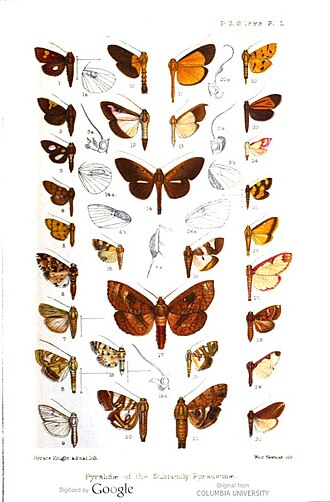| Snout moths | |
|---|---|
 | |
| Meal moth ( Pyralis farinalis ) | |
| Scientific classification | |
| Kingdom: | Animalia |
| Phylum: | Arthropoda |
| Class: | Insecta |
| Order: | Lepidoptera |
| Superfamily: | Pyraloidea |
| Family: | Pyralidae Latreille, 1809 [1] |
| Type species | |
| Pyralis farinalis | |
| Subfamilies | |
| Diversity | |
| c. 6,150 species | |

The Pyralidae, commonly called pyralid moths, [2] snout moths or grass moths, [3] are a family of Lepidoptera in the ditrysian superfamily Pyraloidea. [4] [5] In many (particularly older) classifications, the grass moths (Crambidae) are included in the Pyralidae as a subfamily, making the combined group one of the largest families in the Lepidoptera. The latest review by Eugene G. Munroe and Maria Alma Solis retain the Crambidae as a full family of Pyraloidea. [6]
Contents
The wingspans for small and medium-sized species are usually between 9 and 37 mm (0.35 and 1.46 in) with variable morphological features. [2] [7]
It is a diverse group, with more than 6,000 species described worldwide, and more than 600 species in America north of Mexico, comprising the third largest moth family in North America. At least 42 species have been recorded from North Dakota in the subfamilies of Pyralidae. [8]

